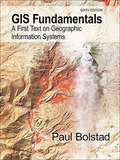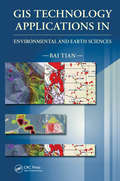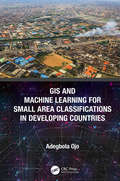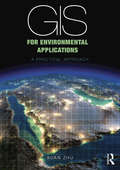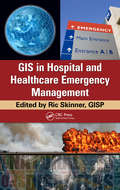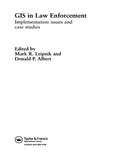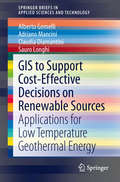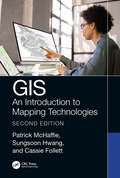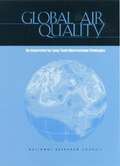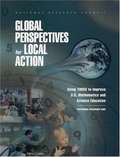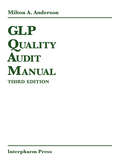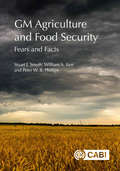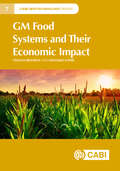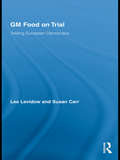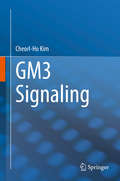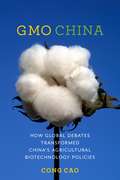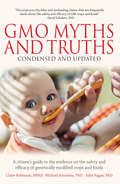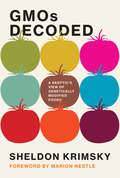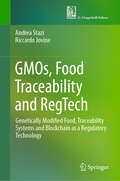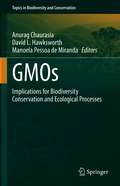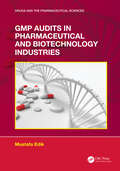- Table View
- List View
GIS Fundamentals: A First Text on Geographic Information Systems
by Paul BolstadGIS Fundamentals: A First Text on Geographic Information Systems
GIS Technology Applications in Environmental and Earth Sciences
by Bai TianThis book starts with an overview of GIS technology, what GIS technology is, what it can do, what software products are available, etc. Then, throughout the book, the author explains with many case studies, programs, maps, graphics, and 3D models how GIS and other related technologies can be used to automate mapping processes, collect, process, edit, store, manage, and share datasets, statistically analyze data, model, and visualize large datasets to understand patterns, trends, and relationships to make educated decisions. This book is an excellent resource for anyone who is interested in GIS and related technologies, geology, natural resource, and environmental science.
GIS and Machine Learning for Small Area Classifications in Developing Countries
by Adegbola OjoSince the emergence of contemporary area classifications, population geography has witnessed a renaissance in the area of policy related spatial analysis. Area classifications subsume geodemographic systems which often use data mining techniques and machine learning algorithms to simplify large and complex bodies of information about people and the places in which they live, work and undertake other social activities. Outputs developed from the grouping of small geographical areas on the basis of multi- dimensional data have proved beneficial particularly for decision-making in the commercial sectors of a vast number of countries in the northern hemisphere. This book argues that small area classifications offer countries in the Global South a distinct opportunity to address human population policy related challenges in novel ways using area-based initiatives and evidence-based methods. This book exposes researchers, practitioners, and students to small area segmentation techniques for understanding, interpreting, and visualizing the configuration, dynamics, and correlates of development policy challenges at small spatial scales. It presents strategic and operational responses to these challenges in cost effective ways. Using two developing countries as case studies, the book connects new transdisciplinary ways of thinking about social and spatial inequalities from a scientific perspective with GIS and Data Science. This offers all stakeholders a framework for engaging in practical dialogue on development policy within urban and rural settings, based on real-world examples. Features: The first book to address the huge potential of small area segmentation for sustainable development, combining explanations of concepts, a range of techniques, and current applications. Includes case studies focused on core challenges that confront developing countries and provides thorough analytical appraisal of issues that resonate with audiences from the Global South. Combines GIS and machine learning methods for studying interrelated disciplines such as Demography, Urban Science, Sociology, Statistics, Sustainable Development and Public Policy. Uses a multi-method approach and analytical techniques of primary and secondary data. Embraces a balanced, chronological, and well sequenced presentation of information, which is very practical for readers.
GIS for Critical Infrastructure Protection
by Robert F. Austin David P. DiSera Talbot J. BrooksGIS for Critical Infrastructure Protection highlights the GIS-based technologies that can be used to support critical infrastructure protection and emergency management. The book bridges the gap between theory and practice using real-world applications, real-world case studies, and the authors' real-world experience. Geared toward infrastructure ow
GIS for Environmental Applications: A practical approach
by Xuan ZhuGIS for Environmental Applications provides a practical introduction to the principles, methods, techniques and tools in GIS for spatial data management, analysis, modelling and visualisation, and their applications in environmental problem solving and decision making. It covers the fundamental concepts, principles and techniques in spatial data, spatial data management, spatial analysis and modelling, spatial visualisation, spatial interpolation, spatial statistics, and remote sensing data analysis, as well as demonstrates the typical environmental applications of GIS, including terrain analysis, hydrological modelling, land use analysis and modelling, ecological modelling, and ecosystem service valuation. Case studies are used in the text to contextualise these subjects in the real world, examples and detailed tutorials are provided in each chapter to show how the GIS techniques and tools introduced in the chapter can be implemented using ESRI ArcGIS (a popular GIS software system for environmental applications) and other third party extensions to ArcGIS to address. The emphasis is placed on how to apply or implement the concepts and techniques of GIS through illustrative examples with step-by-step instructions and numerous annotated screen shots. The features include: Over 350 figures and tables illustrating how to apply or implement the concepts and techniques of GIS Learning objectives along with the end-of-chapter review questions Authoritative references at the end of each chapter GIS data files for all examples as well as PowerPoint presentations for each chapter downloadable from the companion website. GIS for Environmental Applications weaves theory and practice together, assimilates the most current GIS knowledge and tools relevant to environmental research, management and planning, and provides step-by-step tutorials with practical applications. This volume will be an indispensable resource for any students taking a module on GIS for the environment.
GIS in Hospital and Healthcare Emergency Management
by GISP, Ric SkinnerAlthough many books have been published on the application of GIS in emergency management and disaster response, this is the first one to bring together a comprehensive discussion of the critical role GIS plays in hospital and healthcare emergency management and disaster response. Illustrating a wide range of practical applications, GIS in Hospital
GIS in Law Enforcement: Implementation Issues and Case Studies (International Forensic Science And Investigation Ser.)
by Mark R. Leipnik Donald P. AlbertThis is the ideal book for GIS users in law enforcement who want to learn more about the technology or who wish to get started using GIS in their agency. Crime analysts, teachers, and students of criminal justice will also gain valuable insights into a suite of powerful technological tools ideally suited for crime mapping and analysis from this com
GIS to Support Cost-effective Decisions on Renewable Sources
by Claudia Diamantini Sauro Longhi Adriano Mancini Alberto GemelliThrough the results of a developed case study of information system for low temperature geothermal energy, GIS to Support Cost-effective Decisions on Renewable Sources addresses the issue of the use of Geographic Information Systems (GIS) in evaluating cost-effectiveness of renewable resource exploitation on a regional scale. Focusing on the design of a Decision Support System, a process is presented aimed to transform geographic data into knowledge useful for analysis and decision-making on the economic exploitation of geothermal energy. This detailed description includes a literature review and technical issues related to data collection, data mining, decision analysis for the informative system developed for the case study. A multi-disciplinary approach to GIS design is presented which is also an innovative example of fusion of georeferenced data acquired from multiple sources including remote sensing, networks of sensors and socio-economic censuses. GIS to Support Cost-effective Decisions on Renewable Sources is a useful, practical reference for engineers, managers and researchers involved in the design of GIS, decision support systems, investment planning/strategy in renewable energy and ICT innovation in this field.
GIS: An Introduction to Mapping Technologies, Second Edition
by Patrick McHaffie Sungsoon Hwang Cassie FollettThe second edition of this introductory GIS textbook is thoroughly rewritten and updated to respond to the demand for critical engagement with technologies that address relevant issues across several disciplines preparing students for higher-level work in geotechnologies. Chapters are arranged to (1) build competence in fundamental skills, (2) explore applications of higher-level managerial and analytical functions that are typically called upon in public, nonprofit, and private sector milieu, and (3) propose and detail a template for organizing, executing, and completing a GIS project successfully. This interests all users from beginners to experienced professionals. Features: Uses the latest version of ArcGIS Pro (3.0) to present a fully rewritten and updated text with diverse perspectives. Includes many real-world examples with urban planning, environmental, and social justice foci. Presents new discussions, examples, and lab materials on open-source GIS projects. Junior and senior level undergraduate students taking courses in remote sensing and GIS applications, studying in the fields of Geography, Environmental Sciences, Computer Science, Urban Studies, Public Health, and Social Disciplines, as well as researchers and academics in the same fields, will all benefit from the information provided in the updated version of this book.
GISTs - Gastrointestinal Stromal Tumors
by Antonella Messina Elisabetta de Lutio di CastelguidoneThis book aims to provide a complete overview of the diagnosis and treatment of gastrointestinal stromal tumors (GISTs). It has been conceived to be both a detailed guide for clinical practice and an updated reference for all those involved in the evaluation of GISTs imaging. The publication provides comprehensive descriptions of the full range of common imaging and nonimaging techniques used in the diagnosis and followup of GISTs. Techniques reviewed include: Conventional radiography· Endoscopy and endoscopic ultrasound· Conventional, color-Doppler and contrast-enhanced ultrasound· Computed tomography· Magnetic resonance imaging, and· Contrast-enhanced PET/CT imaging. Both medical and surgical treatment strategies are also fully reviewed. Finally, the book concludes with a chapter that aims to stimulate widespread interest in the formation of new GISTs Units. Written by experts in the field, the book is enriched throughout by numerous black-and-white and color images, making it an invaluable source of information as well as an indispensable guide to interpreting images for radiologists, gastroenterologists, pathologists, oncologists and surgeons.
GLG 103 Physical Geology Lab (F17)
by Robert LeightyGLG 103 Physical Geology Lab (F17) by Robert Leighty
GLOBAL AIR QUALITY: An Imperative for Long-Term Observational Strategies
by Committee on Atmospheric ChemistryA report on Global Air Quality
GLOBAL PERSPECTIVES for LOCAL ACTION: Using TIMSS to Improve U.S. Mathematics and Science Education
by Committee on Science Education K-12The National Academies Press (NAP)--publisher for the National Academies--publishes more than 200 books a year offering the most authoritative views, definitive information, and groundbreaking recommendations on a wide range of topics in science, engineering, and health. Our books are unique in that they are authored by the nation's leading experts in every scientific field.
GLP Quality Audit Manual
by Milton A. AndersonDesigned to enable readers to plan and execute their own audits, this comprehensive guide presents discussions of and practical applications related to establishing a GLP QA unit and performing effective GLP audits. The first section provides the foundation of information needed for designing and initiating a Good Laboratory Practice quality assurance program. Section II contains ready-to-use audit checklists and regulatory references that are in accordance with the most recent regulations. Section Ill comprises the full texts of the relevant standards and regulations along with the Priniciples of Good Laboratory Practice.
GM Agriculture and Food Security: Fears and Facts
by Peter Phillips William Kerr Stuart SmythEfforts to improve food security in the developing world have been hampered due to myths surrounding GM agriculture. This book explores the theory, evidence and rhetoric of the impact of food production on the environment, and the impact of the environment on food production. The chapters address: food security and technology; expertise and opportunism; the promise of technology; the politicization of risk; industrial agriculture; the meaning of 'natural'; the potential of the local food movement; food labelling; genetic diversity in the agro-industrial era; sustainability and chemical application; plant vitality; and future prospects for food security. Each chapter includes a personal introduction from the authors about the issues at hand, followed by a detailed analysis with further references. The book considers the origins of concerns and then examines the evidence around the issues, and the impacts in terms of policy, regulation and agricultural practice. It also: - Refutes common consumer and environmental organization myths about biotechnology. - Highlights the importance of food security in both the developing and developed world. - Provides a pro-science approach to increasing food security. This book will be of interest to students and researchers in biotechnology, food security and public understanding of science, and also to policy makers, regulators and industry managers.
GM Food Systems and Their Economic Impact (CABI Biotechnology Series)
by Dr Tatjana Brankov Dr Koviljko LovreThe development of transgenic crops is revolutionary, but what does it mean for food production, prices and the environment? This is the first book to examine the economic evidence in a methodical way. It initially describes the historical evolution of biotechnology and defines key terms, before moving on to explore transgenic technology and food regime concepts. The book analyzes genetically modified organism (GMO) policy as part of overall agrarian policy, considering neoregulation in the USA, the EU, Brazil, Russia, China, India, South Africa and Serbia; as well as discussing agricultural performance, support and trade relations. The effect of transgenic food production on world food prices is also examined, along with food security at global and regional levels, and the links between GMOs and world hunger. The environmental implications of transgenic technology are considered through analysis of pesticide and fertilizer usage and efficiency, and pesticide consumption in GMO and non-GMO producing countries. Finally, the book considers the entry of transgenic ingredients into the food chain and lists the products affected. Key features: - Detailed analysis of economic data. - Comparison of international trends, including BRICS countries (Brazil, Russia, India, China and South Africa) and Serbia. - Evaluation of environmental and food security implications. - Glossary of important terms. This book will be valuable for agricultural economists, including students at Masters and PhD level. It will also be of interest to agricultural engineers, food technologists, nutritionists, industry representatives, policy makers, policy advisers and analysts and NGOs.
GM Food Systems and Their Economic Impact (CABI Biotechnology Series)
by Dr Tatjana Brankov Dr Koviljko LovreThe development of transgenic crops is revolutionary, but what does it mean for food production, prices and the environment? This is the first book to examine the economic evidence in a methodical way. It initially describes the historical evolution of biotechnology and defines key terms, before moving on to explore transgenic technology and food regime concepts. The book analyzes genetically modified organism (GMO) policy as part of overall agrarian policy, considering neoregulation in the USA, the EU, Brazil, Russia, China, India, South Africa and Serbia; as well as discussing agricultural performance, support and trade relations. The effect of transgenic food production on world food prices is also examined, along with food security at global and regional levels, and the links between GMOs and world hunger. The environmental implications of transgenic technology are considered through analysis of pesticide and fertilizer usage and efficiency, and pesticide consumption in GMO and non-GMO producing countries. Finally, the book considers the entry of transgenic ingredients into the food chain and lists the products affected. Key features: - Detailed analysis of economic data. - Comparison of international trends, including BRICS countries (Brazil, Russia, India, China and South Africa) and Serbia. - Evaluation of environmental and food security implications. - Glossary of important terms. This book will be valuable for agricultural economists, including students at Masters and PhD level. It will also be of interest to agricultural engineers, food technologists, nutritionists, industry representatives, policy makers, policy advisers and analysts and NGOs.
GM Food on Trial: Testing European Democracy (Genetics and Society)
by Susan Carr Les LevidowEurope was told that it had no choice but to accept agbiotech, yet this imperative was turned into a test of democratic accountability for societal choices. Since the late 1990s, European public controversy has kept the agri-biotech industry and its promoters on the defensive. As some opponents and regulators alike have declared, ‘GM food/crops are on trial’. Suspicion of their guilt has been evoked by moral symbols, as disputes over whether genetically-modified products are modest benign improvements on traditional plant breeding, or dangerous Frankenfoods; and in disputes over whether they are global saviours, or control agents of multinational companies. This book examines European institutions being ‘put on trial’ for how their regulatory procedures evaluate and regulate GM products, in ways which opened up alternative futures. Levidow and Carr highlight how public controversy created a legitimacy crisis, leading to national policy changes and demands, in turn stimulating changes in EU agbiotech regulations as a strategy to regain legitimacy.
GM3 Signaling
by Cheorl-Ho KimThis book reviews recent progress in understanding of the signaling and biochemistry of GM3 ganglioside in eukaryotic cells. GM3 is the simplest of the gangliosides and the precursor of other gangliosides. It is expressed in the outer leaflet of plasma cell membranes and has roles in the recognition, interaction, binding, adhesion, and motility of cells. In addition, GM3 has been documented to have functional roles in cell migration, proliferation, senescence, and apoptosis. The full range of topics of interest are addressed in the book. The early chapters discuss the synthesis of GM3, its molecular localization in cells, and its basic function as an interacting molecule. The ways in which GM3 exerts its effects via various growth factor receptors are fully explored. Current knowledge of the part played by GM3 in health and disease is discussed in depth. For example, its roles in preventing inflammation, inhibiting tumor angiogenesis and tumor growth, and suppressing arthritis are highlighted, and attention drawn to the significance of GM3 as a driver of impaired wound healing in diabetics. The book will be of interest to all who want a comprehensive update on research in this field.
GMO China: How Global Debates Transformed China's Agricultural Biotechnology Policies (Contemporary Asia in the World)
by Cong CaoIn China, as elsewhere, the debate over genetically modified organisms has become polarized into anti- and pro-GMO camps. Given the size of China’s population and market, much is at stake in conflicts over regulation for domestic as well as international actors. In this book, Cong Cao provides an even-handed analysis that illuminates the tensions that have shaped China’s policy toward agricultural biotechnology in a global perspective.Cao presents a comprehensive and systematic analysis of how China’s policy toward research and commercialization of genetically modified crops has shifted that explains how China’s changing GMO stances reflect its evolving position on the world stage. While China’s scientific community has set the agenda, it has encountered resistance rooted in concerns over food safety and consumers’ rights as well as issues of intellectual property rights and food sovereignty. Although Chinese leaders at first sought to take advantage of the biotech revolution by promoting GMO crop consumption, Cao demonstrates that policy has since become precautionary, as seen in new laws and regulations grounded in concerns over safety and the deferral of commercialization of GM rice. He presents China’s policies in light of changing global attitudes toward GM crops: As shifts in China have closely followed global trends, so has domestic activism. Drawing on government and scientific documents as well as interviews with scientists, officials, policy analysts, activists, and journalists, GMO China is an important book for China studies, science and technology studies, policy analysts, and professionals interested in the Chinese biotechnology market.
GMO Myths and Truths: A Citizen’s Guide to the Evidence on the Safety and Efficacy of Genetically Modified Crops and Foods, 3rd Edition
by Claire Robinson John Fagan Michael AntoniouIt is often claimed that the case against genetically modified (GM) crops and foods is based on emotion, not science, and that to oppose GM crop and food technology is to be anti-science. It is also claimed that GM crops offer higher yields and better nutrition, that they are safe for health and the environment, that they reduce agrochemical use, and that they are needed to feed the world's growing population. This book, co-authored by two genetic engineers and a writer/researcher, exposes these claims as false, using scientific and other documented evidence. GMO Myths and Truths summarizes the facts on the safety and efficacy of genetically modified (GM) crops and foods in terms that are accessible to the non-scientist but still relevant to scientists, policymakers and educators. The evidence presented points to many hazards, risks, and limitations of genetic engineering technology. These include harms found in animal feeding and ecological studies, which in turn indicate risks to health and the environment posed by GM crops and foods. The layout of the book enables those readers with limited time to read the chapter summaries, while providing more detail and full references for those who require them. At 164 pages of paperback size, this new condensed version is shorter and more accessible than the authors' 330-page report by the same name, which has been downloaded over half a million times. The book shows that conventional breeding continues to outstrip GM in developing crops that deliver high yields, better nutrition, and tolerance to extreme weather conditions and poor soils. In agreement with over 400 international experts who co-authored a UN and World Bank-sponsored report on the future of farming, the authors conclude that modern agroecology, rather than GM, is the best path for feeding the world's current and future populations in a safe and sustainable way.
GMOs Decoded: A Skeptic's View of Genetically Modified Foods (Food, Health, and the Environment)
by Sheldon KrimskyThe debate over genetically modified organisms: health and safety concerns, environmental impact, and scientific opinions.Since they were introduced to the market in the late 1990s, GMOs (genetically modified organisms, including genetically modified crops), have been subject to a barrage of criticism. Agriculture has welcomed this new technology, but public opposition has been loud and scientific opinion mixed. In GMOs Decoded, Sheldon Krimsky examines the controversies over GMOs—health and safety concerns, environmental issues, the implications for world hunger, and the scientific consensus (or lack of one). He explores the viewpoints of a range of GMO skeptics, from public advocacy groups and nongovernmental organizations to scientists with differing views on risk and environmental impact.Krimsky explains the differences between traditional plant breeding and “molecular breeding” through genetic engineering (GE); describes early GMO products, including the infamous Flavr Savr tomato; and discusses herbicide-, disease-, and insect-resistant GE plants. He considers the different American and European approaches to risk assessment, dueling scientific interpretations of plant genetics, and the controversy over labeling GMO products. He analyzes a key 2016 report from the National Academies of Sciences on GMO health effects and considers the controversy over biofortified rice (Golden Rice)—which some saw as a humanitarian project and others as an exercise in public relations. Do GMO crops hold promise or peril? By offering an accessible review of the risks and benefits of GMO crops, and a guide to the controversies over them, Krimsky helps readers judge for themselves.
GMOs, Food Traceability and RegTech: Genetically Modified Food, Traceability Systems and Blockchain as a Regulatory Technology
by Andrea Stazi Riccardo JovineThe book deals with the regulation of GMOs within the context of multiple principles and interests, including food security, sustainable development, and biodiversity. The recognition of intellectual property rights, particularly with respect to geographical indications and patentability is also discussed. From a comparative perspective, the importance of traceability in the food industry, driven by major world powers' consumer and market protection policies, is highlighted. Finally the use of emerging technologies, such as blockchain, as a form of "regulatory technology" for more effective and sustainable management of traceability systems within the food supply chain, is explored as a workable and forward looking solution.
GMOs: Implications for Biodiversity Conservation and Ecological Processes (Topics in Biodiversity and Conservation #19)
by David L. Hawksworth Anurag Chaurasia Manoela Pessoa de MirandaThis book covers a broad spectrum of topics related to GMOs and allied new gene-based technologies, biodiversity, and ecosystem processes, bringing together the contributions of researchers and regulators from around the world. The aim is to offer a clear view of the benefits and effects of genetically modified crops, insects, and other animals on the soil microbiome and ecological processes. Contributors examine issues related to the development of risk assessment procedures and regulations designed to maximize benefits while minimizing risks. Beyond the scientific challenges of GMOs, the book explores the broad and contentious terrain of ethical considerations. The contributors discuss such questions as the unintended, possibly unforeseen, consequences of releasing GMOs into ecosystems, and the likelihood that the full effects of GMOs could take years, even decades, of close monitoring to become evident. The importance of developing a precautionary approach is stressed. The final chapter describes the critical issues of governance and regulation of new and emerging gene-based technologies, as nations grapple with the consequences of adopting the Cartagena Protocol on Biosafety (CPB). The volume includes an extensive Annex which outlines legal perspectives on the state of GMO governance around the world, with more than 20 examples from nations in Africa, South and Central America, Asia, Australasia, and Europe.
GMP Audits in Pharmaceutical and Biotechnology Industries (ISSN)
by Mustafa EdikThe fact that good manufacturing practice (GMP) audits in the pharmaceutical and biotechnology industries have to be evaluated, and with very limited resources, has created a gap in this field. The lack of trained and qualified GMP auditors is on the rise in all organizations that are required to implement FDA, EMA, MHRA, WHO, TGA, and PIC/S regulations. This volume is an essential reference source for those organizations operating in the field of health and presents the basic knowledge needed to perform audits. The author also provides useful tips and a selection of samples about GMP audits that are indispensable for professionals and health inspectors working in industry and health authorities.Features An essential reference source for those organizations operating in the field of health and presents the basic knowledge needed to perform audits Anyone working in the manufacturing sector needs to be aware of GMP, be able to identify operational flaws as well as legal violations, and have a clear understanding of how to meet GMP standards Assists readers in understanding the importance of GMP and how they can apply each aspect in their working environment Covers a global regulatory landscape Suitable for relevant degree courses including industrial pharmaceutics and pharmaceutical biotechnology
